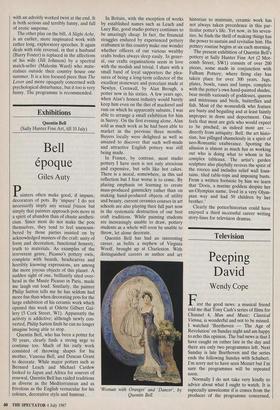Exhibitions
Quentin Bell
(Sally Hunter Fine Art, till 10 July)
Bell époque
Giles Auty
Painters often make good, if impure, decorators of pots. By 'impure' I do not necessarily imply any sexual frisson but simply that painters approach pots more in a spirit of abandon than of chaste aestheti- cism. Since most do not make the pots themselves, they tend to feel unencum- bered by those pieties insisted on by acknowledged masters of the craft: unity of form and decoration, functional honesty, truth to materials. As examples of the irreverent genre, Picasso's pottery owls, complete with beards, headscarves and horribly knowing expressions, are among the more joyous objects of this planet. A sudden sight of one, brilliantly sited over- head in the Musee Picasso in Paris, made me laUgh out loud. Similarly, the painter Philip Sutton tells me he has seldom had more fun than when decorating pots for the large exhibition of his ceramic work which opened this week at Odette Gilbert Gal- lery (5 Cork Street, W1). Apparently the activity is addictive; although newly con- verted, Philip Sutton finds he can no longer imagine being able to stop.
Quentin Bell, who has been a potter for 50 years, clearly finds a strong urge to continue too. Much of his early work consisted of throwing shapes for his mother, Vanessa Bell, and Duncan Grant to decorate. While major potters such as Bernard Leach and Michael Cardew looked to Japan and Africa for sources of renewal, Quentin Bell has raided traditions as diverse as the Mediterranean and as frivolous as the English vernacular for his colours, decorative style and humour. In Britain, with the exception of works by established names such as Leach and Lucy Rie, good studio pottery continues to be amazingly cheap. In fact, the financial struggles endured by experienced pottery craftsmen in this country make one wonder whether officers of our various wealthy crafts bodies always sleep easily. In gener- al, our crafts organisations seem in love with the modish and trivial. I share with a small band of loyal supporters the plea- sures of being a long-term collector of the excellent stoneware and porcelain made at Newlyn, Cornwall, by Alan Brough, a potter now in his sixties. A few years ago, when Alan's honest industry would barely keep him even on the diet of mackerel and rum on which he apparently subsists, I was able to arrange a small exhibition for him in Surrey. On the first evening alone, Alan sold as much work as he had been able to market in the previous three months. Buyers locally were delighted as well as amazed to discover that such well-made and attractive English pottery was still being made.
In France, by contrast, most studio pottery I have seen is not only atrocious and expensive, but sells like hot cakes. There is a moral, somewhere, in this sad reflection but I fear worse is to come. By placing emphasis on learning to create mass-produced gimmickry rather than on making hand-produced objects of utility and beauty, current ceramics courses in art schools are also playing their full part now in the systematic destruction of our best craft traditions. While painting students are increasingly unable to draw, pottery students as a whole will soon be unable to throw, let alone decorate.
Quentin Bell has had an interesting career, as befits a nephew of Virginia Woolf, brought up at Charleston. With distinguished careers as author and art Woman with Oranges' and 'Dancer', by Quentin Bell. historian to maintain, ceramic work has not always taken precedence in this par- ticular potter's life. Yet now, in his seven- ties, he finds the thrill of making things has the power to sustain and revitalise him. His pottery routine begins at six each morning.
The present exhibition of Quentin Bell's pottery at Sally Hunter Fine Art (2 Mot- comb Street, SW1) consists of over 200 pieces, some made in conjunction with Fulham Pottery, where firing clay has taken place for over 300 years. Jugs, plates, bowls, vases and lamps, complete with the potter's own hand-painted shades, bear motifs variously of goddesses, queens and mistresses and birds, butterflies and fish. Most of the womenfolk who feature are busty and beguiling and at least faintly improper in dress and deportment. One feels that most are girls who would expect to be pinched, as indeed most are directly from antiquity. Bell, the art histo- rian, has pillaged shamelessly in a spirit of neo-Romantic exuberance. Spotting the allusion is almost as much fun as working out who is doing what to whom in his complex tableaux. The artist's garden sculpture also playfully revives the spirit of the rococo and includes relief wall foun- tains, tiled table-tops and imposing busts. From a written footnote by him we learn that 'Doris, a marine goddess despite her un-Olympian name, lived in a very Olym- pian way and had 50 children by her brother.'
Clearly the potter/historian could have enjoyed a third successful career writing story-lines for television dramas.


















































 Previous page
Previous page